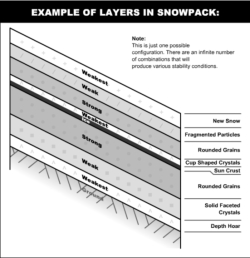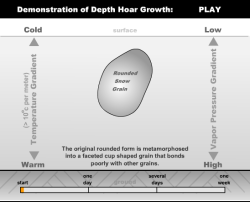
Click image for more information
Courtesy:
Forest Service Avalanche Center
Jim Conway, Graphic Artist
https://www.fsavalanche.org/
 Depth Hoar
Depth HoarClick image for more information
and a deformation animation
Courtesy:
Forest Service Avalanche Center
Jim Conway, Graphic Artist
https://www.fsavalanche.org/
Water is our planet’s magical molecule, changing states faster than a presidential candidate. Snowpacks vaporize, ice melts and re-freezes, lakes evaporate, and cooled water vapor condenses back as clouds, snowflakes and hoarfrost. The muffled silence of the winter snowpack belies its dramatic pace of transformation.
In his book entitled “Life in the Cold”, author Peter Marchand explains the dynamic nature of the snowpack. Within a few hours after a snow storm, destructive metamorphism sets to work on the newly fallen snow. The delicate crystalline structure of each snowflake is quickly degraded. The intricate flakes transform to amorphous icy grains. Wind, warmth and compression accelerate destructive metamorphism, leaving a firmer, denser snowpack. At the surface, not only does snow strongly reflect the weak warmth of winter sunlight, but on a clear night, it radiates energy, greatly cooling the surface.
Meanwhile, the soil beneath the snowpack is typically warmer than the overlying snow, which is why springs can run all winter long. Three feet underground, soil temperature is within a few degrees of that location’s average annual air temperature. Sandwiched between the warm soil and the cold air, the blanket of snow is a great thermal insulator; fresh snow is the equal of fiberglass insulation. As a result, soil warmth transforms snow deep under the snowpack into water vapor. This moisture spreads through air spaces in the snowpack, following the thermal gradient to the chilly snow surface. As the moisture vacates the lower layers, a brittle porous layer develops in the snowpack. Termed “depth hoar”, it is weak, icy and prone to collapse. When the heavy overlying snowpack shifts, the crumbly depth hoar can release an avalanche, a powerful reminder of snowpack transformations for any backcountry traveler.
Come spring, every particle of Utah’s snowpack undertakes its final transformation. Some sublimates to waft away on warm springtime winds. Most of it melts away to feed the groundwater, springs and streams that give us cool relief on a hot summer day and provide the precious water that every Utahn depends on.
This is Linda Kervin for Bridgerland Audubon Society.
Credits:
Graphics: Courtesy Forest Service Avalanche Center, https://www.fsavalanche.org/
Text: Jim Cane, Bridgerland Audubon Society
Additional Reading:
Life in the Cold by Peter Marchand:https://www.upne.com/9619460.html
Forest Service National Avalanche Center, Avalanche Awareness Website: https://www.fsavalanche.org/
Depth Hoar: https://www.fsavalanche.org/encyclopedia/depth_hoar.htm
Utah Avalanche Center: https://utahavalanchecenter.org/
